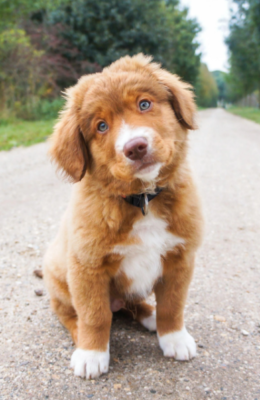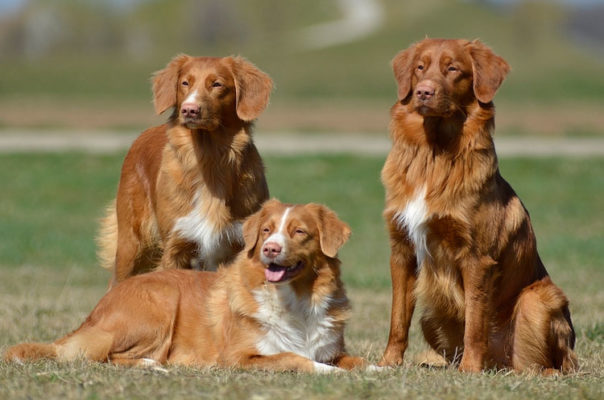Nova Scotia Duck Tolling Retriever
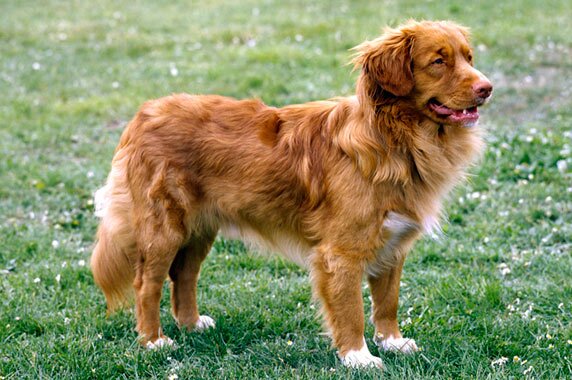
Its sharp mind and calm temperament distinguish the Nova Scotia Duck Tolling Retriever. It is an obedient and loyal dog to its owner. The pet is very friendly and sociable, quickly becoming attached to family members. The dog does not tolerate loneliness. It requires a lot of human attention. Yarmouth Toller loves children and active games.
Table of Contents
Breed Information
| Another Name | Yarmouth Toller, Tolling Retriever, Little Red Duck Dog, Little River Duck Dog |
| Origin | Canada (Nova Scotia) |
| Height | Males 45-54 cm Females 42-51 cm |
| Weight | 17-23 kg |
| Fur | Long |
| Color | Red with red hues |
| Lifespan | 12-14 years |
| FCI Classification | Retrievers – Flushing Dogs – Water Dogs |
| Group | Hunting dogs, dogs for children |
| Price | $1500-2500 |
Breed Photos
Origin History
The Nova Scotia Duck Tolling Retriever, or Yarmouth Toller for short, first appeared in the 19th century in Nova Scotia, Canada. Hence the name of the breed. This small, sturdy dog was famous for hunting water game. The Yarmouth Toller was so valued by hunters that there was a ban on taking it out of the country.
In 1950, the breed was recognized by the Fédération Cynologique Internationale. Canadian cynologists recognized the breed five years earlier. In the 80s, dogs were very much loved in Europe, especially in Scandinavia. At the same time, in 1987, the standard for the breed was adopted. In the United States, the retriever was recognized only in 2003.
Appearance
The Nova Scotia Duck Tolling Retriever is a stocky, harmoniously built dog with a compact rectangular body. The chest of the dog is voluminous and deep. The back is straight; the abdomen is taut. The neck is of medium length. It has a wedge-shaped volumetric head with a convex forehead. The ears are not long, triangular, tight to the head. The eyes are wide-set, brown.
The limbs are muscular, strong, with large, strong paws. The tail is not long; it is downcast. The coat is long, dense, and thick. The color is usually red with red shades.
Character
Its sharp mind and calm temperament distinguish the Nova Scotia Duck Tolling Retriever. It is an obedient and loyal dog to its owner. The pet is very friendly and sociable, quickly becoming attached to family members. The dog does not tolerate loneliness. It requires a lot of human attention. Yarmouth Toller loves children and active games. With other pets, easily find a common language. Towards strangers is wary, has good guarding qualities.
The Nova Scotia Duck Tolling Retriever is a fairly active and energetic dog. It performs well not only in hunting but also in various sports. For example, Frisbee, flyball, agility.
Care
Compact family pets can be kept in an apartment. But representatives of the breed are very energetic and require regular walks and exercise from the owner. Therefore, it is better to have a dog in a country house with a plot. It is not recommended to put it on a chain.
Pet’s hair is long and needs daily brushing with a brush with sparse teeth. It is not necessary to bathe the pet often, as its hair is good at repelling dirt. Trim the Nova Scotia Duck Tolling Retriever’s claws once every 1-2 weeks. Don’t forget to clean your pet’s ears and eyes.
Training
The Nova Scotia Duck Tolling Retriever is a curious and obedient dog that is fairly easy to train. Training should begin at the age of six months. Early socialization is important for the dog. Training is best done in the format of active games so that the cheerful pet is not bored and not distracted. Then the dog will grasp everything on the fly. The training process should include a lot of physical activity, as the retriever is quite an athletic dog.
Common Diseases
The Nova Scotia Duck Tolling Retriever has good health. The dog is not prone to allergies and digestive problems. But retrievers are still prone to some hereditary diseases:
- hip dysplasia;
- progressive retinal atrophy;
- heart defects;
- cryptorchidism;
- incorrect bite;
- thyroid disease.
Pay special attention to your dog’s eye and ear health. Monitor his nutrition and take him to the veterinarian for checkups and vaccinations.
Nutrition
The Nova Scotia Duck Tolling Retriever is an unpretentious eatery but requires a balanced diet. Both natural food and dry premium food are suitable. The basis of the diet of the four-legged should be lean meat. Dairy products, eggs, and saltwater fish are excellent complements. Do not forget about fruits, vegetables, and cereals. From there, the pet will get the necessary energy, as well as vitamins and minerals.
Adult dogs should be fed twice a day, puppies three to six times a day. Try not to overfeed the retriever, who is prone to obesity. Exclude fried, salty, smoked, fatty, sweet, and floury foods from his diet. Potatoes, bread, garlic, pasta, and sausage should also be avoided.
 German Pinscher
German Pinscher Petit Basset Griffon Vendéen
Petit Basset Griffon Vendéen Miniature Pinscher
Miniature Pinscher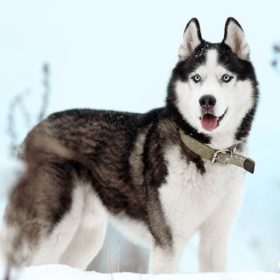 Siberian Husky
Siberian Husky Nenets Herding Laika
Nenets Herding Laika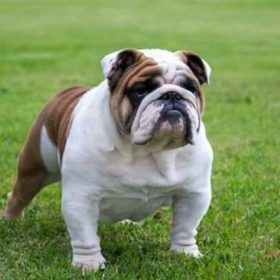 Bulldog
Bulldog
